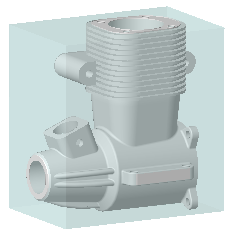To Define an Enclosure Volume
An enclosure volume feature is a closed quilt that defines a volume envelope that surrounds a model. You can use the enclosure volume feature in downstream applications, such as a CFD (computational fluid dynamics) analysis of the external flow over a part.

In the image, a transparent appearance has been applied to the enclosure volume feature.
1. To open the Enclosure Volume tab:
◦ In a part, click > > .
◦ In an assembly, click > > > .
The Enclosure Volume tab opens. A six-sided quilt appears as a bounding box around the model. The walls of the quilt are oriented perpendicular to the x-, y-, and z-axes of the selected coordinate system. Each side of the quilt has a distance of 0.0 from the model.
2. Optionally, to select a different coordinate system to orient the volume, click the Orientation collector, and select a coordinate system.
3. Optionally, to edit the distance of each side of the quilt in relation to the model, perform one of these actions:
◦ Drag the handles away from the model.
◦ Type a positive value in the dimension boxes.
◦ Click the Options tab, and under Linear offsets, type a positive value in the dimension boxes.

1. Coordinate system
2. Drag handles
3. Arcs
If the model dimensions change, the distance dimensions are not updated unless you edit the definition of the enclosure volume feature.
4. Optionally, to rotate the enclosure volume in relation to the model, perform one of these actions:
◦ Rotate the arcs of the dragger around the axes.
◦ Click the Options tab, and under Rotational offsets, type a value in the angle boxes.
5. Click  OK. An
OK. An  enclosure volume feature appears in the Model Tree.
enclosure volume feature appears in the Model Tree.
 OK. An
OK. An  enclosure volume feature appears in the Model Tree.
enclosure volume feature appears in the Model Tree.